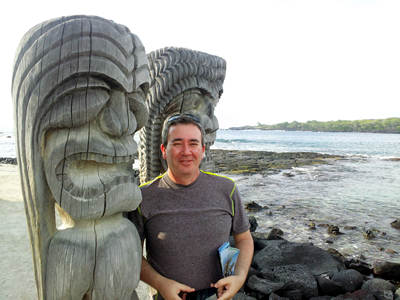Julio C Rodríguez
CLT Director | Moore Hall 256 | julio.rodriguez@ hawaii.edu | ![]()
My work is situated at the intersection of language learning and technology. Within this broad area, I am particularly interested in the integration of technology into language teacher and faculty development programs, project-based language learning, materials development, online course design, and design-based research. The intersection between those areas of language learning and technology present enormous opportunities, quite possibly many more than one could even begin to explore in a lifetime. View my profile for more information about how I ended up in the middle of the Pacific Ocean.
Profile
My interest in technology and language learning started back in the late 80’s, when I designed a study to understand how video could enhance language acquisition. A couple of years later, I found myself teaching English in a language institute that used a video-intensive approach to language learning. My continued interest in this area motivated me to pursue an M.A. in Applied Linguistics with an emphasis on computer-assisted language learning. After completing an MA in this area, I taught ESL and undergraduate English Composition courses for a couple of years and then decided to pursue a Ph.D. in Curriculum and Instructional Technology. Because of my background in applied linguistics and my interest in teacher and faculty development, it seemed natural to focus on technology in language teacher education. I still find this a fascinating and nuanced field with many yet unexplored areas.
Toward the end of my doctoral studies, I became the director of the Language Studies Resource Center (LSRC) in the Department of World Languages at Iowa State University. Some of my accomplishments as director of the LSRC included the restructuring of the Center to better support faculty and students, the development of a successful, award-winning online course in 2006 (Latin 101-102), which lead to the development of many more online language courses, the development of electronic reading materials for Spanish with emphasis on business, engineering, and agriculture, and the adoption of open-source tools.
I have a keen interest in open education initiatives. Within this paradigm, I am interested in open source tools that can support language learning and open educational resources (OER’s). As director of the LSRC, one of the initiatives I supported was the installation of open-source tools on all Center computers in 2007. At a time when securing basic language tools (e.g., spellcheckers for Arabic) through commercial products presented substantial financial challenges, open-source offered a cost-effective alternative.
The potential of open-source software is evident in language teacher education. I believe that language teacher education programs need to be realistic in terms of the tools and resources that teachers can expect their students to have at their disposal once they are in the field. The use of commercial products is problematic, particularly in learner-centered instructional contexts, since it is often difficult for learners to have access to sophisticated or expensive tools. The power of technology is best seen in the hands of the learners. Open source software enables that scenario, so it makes sense to support its use in teacher education contexts.

After a few years directing the LSRC, I took another challenge: leading curriculum development for online courses for Engineering-LAS Online (ELO). I worked in this area for two years, which gave me the opportunity to become acquainted with the challenges and opportunities of online teaching and learning. I lead a team of amazing individuals whose talents included graphic and instructional design, coding, and photogrphy. We were responsible for the maintainance of over 100 online courses and produced over 40 new courses, many of them through a grant incentive program. The design and development of many of these courses was anchored to research on online teaching and learning.
In 2011, I joined the faculty of the College of Languages, Linguistics & Literature at the University of Hawai‘i at Mānoa as Director of the Center for Language & Technology (CLT), formerly Language Learning Center, and associate director of the National Foreign Language Resource Center (NFLRC). During my tenure as director, the CLT has refocused its mission to support the integration of technology into the content areas of the college. We are doing so by providing technical support and professional development to instructors across the College and by helping establish and implement procedures that enable the creation of quality online learning experiences for our students.
The CLT is home to two national centers which extend its functions: the National Foreign Language Resource Center (NFLRC), a Title VI program funded by the U.S. Department of Education, and the Language Flagship Center for Technology Innovation (FCTI), sponsored by the U.S. Department of Defense.
Center for Language & Technology
1890 East-West Rd. Moore Hall 256
Honolulu, HI 96822
Phone | 808.956.8047
Fax | 808.956.5134
cltmanoa@hawaii.edu